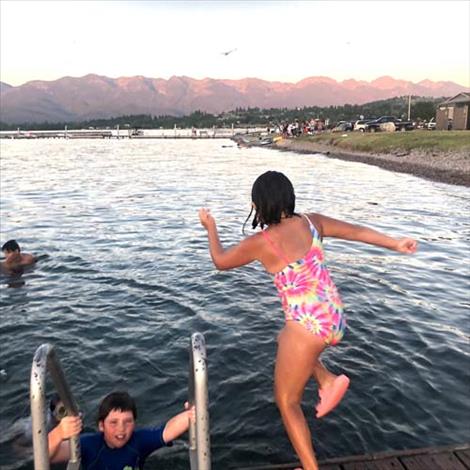Heatwave hits Flathead Reservation, continued high temps forecasted
Hey savvy news reader! Thanks for choosing local.
You are now reading
1 of 3 free articles.
With fireworks crackling, temperatures in the 90s and a thunderstorm on the horizon, C.T. Camel, fire prevention specialist for the Confederated Salish and Kootenai Tribes, was worried last week. It’s hard to believe the weekend delivered much relief.
While last Thursday’s thunderstorm brought a modest amount of moisture, it also increased the danger of lightning-sparked fires. And high temperatures are forecast for at least the next two weeks.
“It looks green out there, but the grass is actually curing underneath and we’re not getting much recovery at night,” he said. Fire danger is high, and he anticipates that after Monday’s weekly meeting between the Lolo National Forest and Flathead Reservation, fire managers will bump it up to very high, with extreme not far behind.
Two major rain events this spring, one that dumped three inches and another that delivered one-and-a-half, were both a bane and blessing for reservation lands. On one hand, the moisture helped fields and forests recover after a dry winter. On the other, rain fueled more growth in the understory, which is now drying out from high temperatures and wind, and setting the stage for more intense fires.
On April 7, a blaze west of Dixon scorched more than 300 acres. According to Camel, sparks from a Montana Rail Link maintenance project ignited the Sinkhole Fire.
“It was really dry and a lot more intense than it should have been for that time of year,” he says. “We figured we were in trouble, then we got those two rain storms which slowed things down a little bit.”
The CSKT fire division successfully attacked two small fires last week – one along the east shore of Flathead Lake and another up St. Mary’s canyon, east of St. Ignatius. Both were human caused, “and moved more than they should have,” says Camel.
“We just need people to be vigilant,” he adds. “They need to understand when they’re outdoors recreating or working to be safe and don’t do anything that’s going to strike a spark.”
Tips include:
• Avoid driving in tall grass, where exhaust pipes can spark a fire.
• When towing a trailer, wrap chains up high so they’re not dragging on the ground.
• Make sure campfires are extinguished completely and cool to the touch, and confine smoking to bare ground.
The fire division, which hires about 80 employees during the peak months of July-September, is busy throughout the year with thinning and fuel-treatment projects across the reservation. But despite those efforts here and elsewhere, drought and higher temperatures are pushing fire danger in the West to historic levels.
Camel noted that one of the fire division’s helicopters was dispatched to Warm Springs, OR, last week where the daytime temperature was perched at 115 degrees.
“The Northwest is getting hit hard with this heat wave,” he says.
Water, water, water
Aside from fire danger, the intense heat can pose health risks. Dr. Tyler Thorson, a family doctor at St. Luke Community Healthcare, emphasizes that hydration is key.
During hot weather, people need at least 64 ounces of fluids, unless told otherwise by their healthcare provider. And not all liquids are the same. Thorson recommends avoiding sugary and caffeine-laced drinks and alcohol, which all cause increased urination and, in turn, dehydration.
“Avoidance is next best,” he says. “Only be out in the sun if you have to and try to avoid afternoon hours when the temperature is peaking. Stick to the shade and wear loose-fitting breathable clothes.”
Prolonged heat exposure can cause fatigue and thirst – the first sign that it’s time to take a break and cool off. “If you push beyond that, people can start to feel dizzy or lightheaded,” he says. Symptoms of heat stroke include passing out, confusion, slurring words and “an overall change in your ability to think or process.” At that stage, it’s important to seek medical care.
While working in the Emergency Room at St. Luke hospital last week, Dr. Thorson saw a few patients taxed by the heat “but overall I think people are doing a good job of avoiding it.”
He reminds those who don’t have air conditioning in their home or workplace that “you’re going to be sweating a lot and losing more fluid than you think, so really staying up on hydration is important.”
He suggests running a fan, since moving air helps cool the body, and seeking out cooler environs, like a restaurant or movie theater.
Infants, toddlers, people over 65 and those with chronic medical conditions like diabetes or hypertension are especially at risk. “The younger and older populations have a harder time regulating their body temperature so they may not sweat as effectively as other people,” he says.
In Montana, where central air conditioning remains relatively rare, the spike in temperatures has caused a run on air conditioners. Zack Aman, a salesperson at Ace Hardware in Polson, says the store ordered “as many as we could” from the warehouse this spring, in anticipation of a hot summer.
“We had a big demand while we had them,” he adds, noting that last time he checked, there were none available from Kalispell to Ronan. He expects to receive some smaller window units, and encourages customers to check with online retailers as well.
Meanwhile, those looking for relief can try shading windows, especially those facing south and west, checking the weather seal around doors and windows and deploying fans to keep the air moving. People can also create their own air conditioning by filling a shallow pan with a mixture of ice and salt (which lowers the freezing point of water) and placing it in front of a box fan.
The easiest way to beat the heat, according to Aman: “A lot of people just go to the lake.”
















